The Road to Damascus
Sorting Modern Pattern Welding
from Myth and Legend
By Kevin R. Cashen, American Bladesmith Society
(ABS) certified Master Bladesmith Damascus steel, the stuff
of legends. In almost every iron working culture this material was revered and
bestowed with magical qualities. A crafty weathered old smith made the elements
do his bidding in his dark, mysterious smithy as he performed the impossible,
fusing solid, different metals to create a weapon that could slay the mightiest
dragon and never fail its master. Is it the pinnacle of the metal formers art?
Can we have the perfect blade with steel that is malleable and tough
intertwined with super hard steel with scary cutting ability?
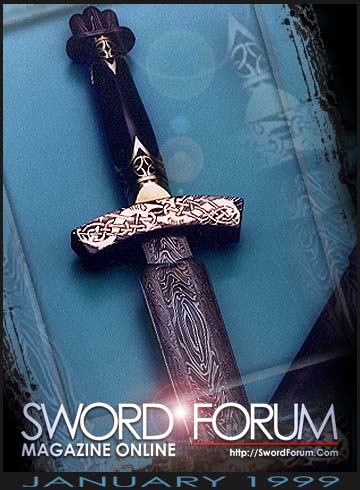 I must start by saying that our
society has used entirely incorrect terminology when labeling these materials.
The layered patterned steel we are used to today would be more appropriately
referred to as pattern welded or laminate steel. Many believe that the steel
from the city that is its namesake was a whole different steel entirely. But
since it has become an integral part of our language, I will resign myself to
this incorrect terminology to avoid confusing things any farther. I did,
however, feel it was necessary to make this point before continuing. I must start by saying that our
society has used entirely incorrect terminology when labeling these materials.
The layered patterned steel we are used to today would be more appropriately
referred to as pattern welded or laminate steel. Many believe that the steel
from the city that is its namesake was a whole different steel entirely. But
since it has become an integral part of our language, I will resign myself to
this incorrect terminology to avoid confusing things any farther. I did,
however, feel it was necessary to make this point before continuing.
In order to understand the development of pattern welding, one must look at
the metal production methods of those very early days. The simplest way of
obtaining iron from ore or iron oxide is by the method known as the direct
process. Iron ore was placed in a large primitive furnace with liberal amounts
of charcoal fuel, which was burned to produce the tremendous heat required.
But, more importantly, it also produced carbon monoxide. The carbon monoxide
passed through the super heated iron oxide stripping away oxygen as it went.
Carbon dioxide was formed with the extra oxygen; thus leaving purer iron
particulates that drizzled down to the bottom of the furnace to form a dirty,
porous iron "sponge" called a bloom. This bloom was removed and
hammered while hot to squeeze out the silicates and other contaminates and to
close the voids. This produced very small amounts of iron in comparison to more
modern means and the metal was fairly crude due to the fact that it never
totally achieved a true molten state.
With this, or naturally occurring bits such as meteoric or bog iron, being
the only source, iron was a scant commodity. These small chunks of iron would
then be packed into a closed vessel with a heavy carbon bearing material and
heated to a high temperature for many hours or even days. The time at
temperature allowed the iron to absorb the carbon via carbon migration (the
tendency for carbon to be absorbed into iron until a sort of equilibrium is
achieved will be back to haunt us many times in this discussion), a process we
now know as Cementation. When the pieces emerge from this treatment they are
steel, an alloy of carbon and iron. When several small chunks of steel were
achieved they could then be heated in a forge and welded together to form
larger pieces. It is almost inevitable that in the process of welding one will
fold the steel back upon itself to build up the mass as the work piece
lengthens and becomes thinner. The subsequent hammering and welding also
refines and purifies the steel further as well as evenly distributing carbon.
This crude steel was improved by hammering! It was also made even better by
folding! A legend was born.
The smiths of medieval Japan developed a method of metal refinement that was
unique to them and very effective. Using an iron rich sand, the same basic
methods used in the direct process were utilized but the bloom was allowed to
cool so that it could be removed from the spent furnace and examined. Select
pieces of steel were broken from a bloom which ranged from very mild steel to
cast iron. The selected parts were then welded together and folded upon
themselves repetitively to refine the metal known as Tamahagane.
Early welded blades by Celtic tribes were straight rods welded together with
the seams running lengthwise along a blade of lower carbon content steel.
Writings indicate how unimpressed the Romans were with these blades, as they
bent easily in battle and split out as the welds failed. But during the time
known as the Migrationary period (400-800 A.D.) true pattern welding appeared.
If the rods that created the long lengthwise seams in the blade were twisted
together, the problem of welds coming apart was greatly reduced. The great
amount of oxide scale produced by forging would break free and fall off during
the twist, resulting in better welds. Twisting is also a great test of how
sound the welds are. If the welds were not good, the stress of twisting would
let you know immediately. So, the twisted pattern could actually have been a
mark of quality very early on. There could have been many other practical
reasons for twisting in the beginning, but soon the development of intricate
patterns in the blade became an art form unto itself. Analysis of the steel in
such blades shows some bands of steel with a relatively high phosphorus
content. The higher phosphorus would cause the steel to etch out lighter than
the purer steel.
When one gets a rare glimpse at one of these original swords you are moved
by how gorgeous the pattern still is in a thousand year old blade that is
mostly rust. That these weapons were fit for kings is echoed in the fact that
even after they were abandoned for homogenous steel, some swords still bore an
inserted panel of simulated pattern welding. I almost have to refrain myself
from anger when I hear the smiths of northern and central Europe, in the dark
ages, stereotyped as uncivilized barbarians. Examples of Saxon and Viking
blades with multiple bar cores of intricate patterning with fine steel edges
welded continuously around the outside speak loudly of metal working skills
unparalleled in their time. Many other cultures made laminated steels but none
developed patterns with the same class as these folks. Trust me when I say that
it is not the easiest thing to do even today with the absolute best tools
available!
Other cultures were also able to go beyond the subtle all silver-gray
damascus by the use of different alloys, centuries before there was any real
scientific understanding of it. More than one culture in utilizing float iron
stumbled upon the high contrasting strange iron that fell from the sky.
Meteorite was sought after ages ago for the beautiful effect its high nickel
content had upon the steel. Good examples of vibrant patterned Kris blades from
southeast Asia can be found that purposefully had high nickel meteoric iron,
producing a bold, black and silver contrast.
Many believe that the material that was the original Damascus steel was a
product of India known as wootz. The town of Damascus was never a great
producer of steel but rather the hub of the great trading network in the Middle
East at the time; thus most blades of this steel came to the west from
Damascus. Interestingly enough, wootz is not a product of folding and welding
two different metals at all, but some of the world's first examples of
homogenous high carbon steel. One of the qualities of steel that the Indians
took advantage of was the fact that the more carbon steel has, the lower its
melting point. Other cultures were hindered by the heat limitations for melting
iron. To get iron to a complete liquidus requires much more heat than the
direct process can produce. The Indians packed the raw iron into tightly sealed
crucibles with carbon bearing material and then heated them for some time in
large fires. As the iron absorbed the carbon in its sealed environment, it
would lower its melting temperature. The lower the melting temperature the more
carbon was absorbed until a vicious circle was formed within the crucible,
resulting in a fairly clean, cast, high carbon steel. Folding and welding to
build up mass and cementization was not necessary. The pattern in wootz is
caused by the large amounts of carbon (cementite) in the steel.
Tamahagane, pattern welding, and wootz were the best steels ever
produced in their time but we have a tendency to think that they were abandoned
because we got lazy or wished to sacrifice quality for quantity, as armies grew
larger. But the fact is that mankind spares no expense in war and would not
abandon quality weaponry for something that wouldn't give an advantage in
battle. As foundry technology improved, the blooms coming from the furnaces
grew in size until it just wasn’t necessary to weld rods together any
more. Wootz held on as a quality product for some time, but even the true
damascus steel eventually became obsolete in the face of better efficiency. The
Catalan furnace eliminated the need to tack scarce quantities of steel
together. And, with the advent of the Bessemer process, man had the ability to
produce any quantity of steel he wished.
In its day, damascus steel in its various forms was far superior to iron, as
was an abacus to counting upon ones fingers and toes. Today, however, nobody
doubts the superiority of a 400mhz PC to the antiquated abacus for crunching
numbers. For some reason, steel is different in our minds. The fact is that
today we produce huge quantities of the finest materials ever made for purity,
consistency, strength, and so on. Our understanding of alloys and metallurgy
allows us to create steels that make many of the ancient ones look like the
slag from our furnaces. Few today, however, would have the skill or the
patience to produce such a weapon with those tools and materials. So these
points are by no means a criticism of the blades of the past, just a reality
check. DaVinci used some pretty lousy mixtures in his paints compared to what
is available today (many paintings are virtually self-destructing), yet I don't
believe there is anybody alive today that can match a DaVinci. Leonardo was the
master and his work has an unsurpassable immortality despite how superior our
modern materials may be. The same is true of the bladesmiths of the past.
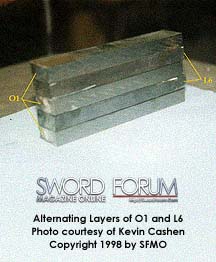 How is this stuff made anyhow?
Many of the original methods are buried so far back in history there is no way
to describe the specific techniques. But it would suffice to say that any body
who plays with hot iron in a heat as clean as a pure charcoal fire will
inevitably stumble upon forge welding. I can share with you my methods, which
seem to work well for myself other smiths. Starting with five layers of two
different alloys (e.g., three layers O1 and two layers L6), I stack them,
alternating, in a bundle. A handle is welded on for easier handling and the
heating begins. When the stack starts to glow bright red, I apply a flux in the
form of powdered borax. The flux liquefies at this high temperature and coats
the steel, preventing oxidation that would put an end to any hopes of welding.
In its liquid state the flux also acts as a medium into which iron oxide and
other contaminants can dissolve and be carried out upon welding. The steel is
placed back in the fire and heated to welding temperature. Many blacksmiths
used to working with wrought iron believe that welding temperature is when the
steel sparks. For carbon steels this is "burning" temperature and you
will ruin it. How is this stuff made anyhow?
Many of the original methods are buried so far back in history there is no way
to describe the specific techniques. But it would suffice to say that any body
who plays with hot iron in a heat as clean as a pure charcoal fire will
inevitably stumble upon forge welding. I can share with you my methods, which
seem to work well for myself other smiths. Starting with five layers of two
different alloys (e.g., three layers O1 and two layers L6), I stack them,
alternating, in a bundle. A handle is welded on for easier handling and the
heating begins. When the stack starts to glow bright red, I apply a flux in the
form of powdered borax. The flux liquefies at this high temperature and coats
the steel, preventing oxidation that would put an end to any hopes of welding.
In its liquid state the flux also acts as a medium into which iron oxide and
other contaminants can dissolve and be carried out upon welding. The steel is
placed back in the fire and heated to welding temperature. Many blacksmiths
used to working with wrought iron believe that welding temperature is when the
steel sparks. For carbon steels this is "burning" temperature and you
will ruin it.
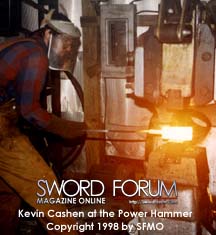 At the right temperature the flux
will flow very evenly over the orange glowing billet and a few bubbles will
"skitter" on the surface. It is hard to describe the proper time, as
it is a sense that is developed from experience. At the right temperature the
billet is quickly removed from the fire and lightly hammered solid. Liken this
to heating two pieces of wax until they are very soft and then pushing them
together. Unlike modern welding, there are no puddles or beads of liquid metal,
so the layers maintain their separate qualities (with the exception of carbon
content). At the right temperature the flux
will flow very evenly over the orange glowing billet and a few bubbles will
"skitter" on the surface. It is hard to describe the proper time, as
it is a sense that is developed from experience. At the right temperature the
billet is quickly removed from the fire and lightly hammered solid. Liken this
to heating two pieces of wax until they are very soft and then pushing them
together. Unlike modern welding, there are no puddles or beads of liquid metal,
so the layers maintain their separate qualities (with the exception of carbon
content).
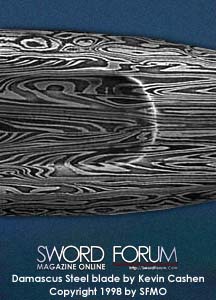 When the layers are forced together,
the flux between them is ejected in a molten sheet of sparks, making things
real interesting in the shop. If all went well, there is now a solid bar
consisting of five layers. This is then hammered out to twice its original
length and then cut 3/4 of the way through, in the middle, to allow folding.
Before the fold, I use a hand held grinder to quickly grind the surfaces clean
of scale and decarburised iron. It is then fluxed, folded, and welded again.
This process is repeated until the desired number of layers is achieved. When the layers are forced together,
the flux between them is ejected in a molten sheet of sparks, making things
real interesting in the shop. If all went well, there is now a solid bar
consisting of five layers. This is then hammered out to twice its original
length and then cut 3/4 of the way through, in the middle, to allow folding.
Before the fold, I use a hand held grinder to quickly grind the surfaces clean
of scale and decarburised iron. It is then fluxed, folded, and welded again.
This process is repeated until the desired number of layers is achieved.
With the revived popularity of this material in recent years has come
abundance. Just about every person forging blades eventually gets around to
making some damascus. Unfortunately, good stuff and good makers are few and far
between. The major contributor to this problem is misinformation. Here is where
all the mythology and folklore has hurt the most. At the top of the list is the
many legends of the superior nature of the material, which I hope I have
thoroughly covered by now, but there are many other myths surrounding this
mysterious metal such as the following:
Myth #1
- If there is one bit of information that seems impossible to dispel it is
the concept of a super steel for blades being created by layers of high carbon
(hard) and low carbon (soft). The idea being hard layers giving the edge
holding, cutting ability, and the soft layers holding everything together by
bending or flexing instead of breaking. This is a myth! Unfortunately it just
isn't that simple, and every time a smith mixes mild steel into his damascus,
and gets a tougher blade from it, the myth is perpetuated. What has actually
occurred in this situation is carbon migration from the high carbon steel to
the low carbon steel until all layers are of medium or lower carbon content. It
makes a very tough blade, but much of its edge holding ability has been
sacrificed. A fellow bladesmith drummed the easy formula even into my thick
skull before publishing it in a popular knife magazine. The mathematics is
simple. If you start with two layers of .8 % carbon (high carbon) and three
layers of .18% carbon (low carbon), fold as much as you want, and the billet
still started out at 40% high carbon and 60% low carbon. Multiply 40% by .8%
and 60% by .18% and add the two together and you get a lackluster total of .44
% carbon. This carbon percentage would be barely hardenable, and with time at
welding heat you would lose even more. Many smiths who add low carbon steel in
the mix complain that they have to use extreme quenches like water or brine to
get any noticeable hardness. One should take a hint from this.
In testing
these concepts, I have broken literally buckets full of laminated material, and
not once has a high carbon/low carbon mix resulted in a break that would
characterize this holy grail. No clean breaking hard layers sandwiched between
stretched and bent malleable layers. To achieve this, one needs a metal that
carbon does not like. In recent years this was found. With care, pure nickel
can be welded to high carbon steel. The contrast is beautiful, but no matter
how you heat-treat it, nickel cannot form martensite (the hard form of steel).
Higher nickel content steel can also retard the process. So here we have it,
very hard layers between tough softer stuff, but I have heard plenty of
complaints from people who have used such blades and found their edge holding
ability lacking. It seems that when this long sought after material was finally
achieved, it was not a real great cutter. Solution--use only good hard steel at
the very edge and keep the soft stuff in the spine and body of the blade. A
good rule of thumb for damascus is never put anything at the cutting edge that
wouldn't make a good knife all by itself.
Myth #2
- Despite popular belief the art of damascus making was not a lost secret
that was only recently rediscovered. It does however make the story that it is
an ancient, secret, super-steel more believable and interesting. Fine examples
of pattern welding exist from earlier in this century and the last. Examples
made in France in the last century have legible words and sentences welded into
the layers. The basic process is actually a simple technique that any
blacksmith accomplished in forge welding can perform. The aforementioned kris
blades have been skillfully made in primitive jungle forges with simple tools
from ancient times right up to the present. It would seem that only a hand full
of westerners forgot how to make the stuff.
Myth #3
- More a misunderstanding than myth is the concept of layers being equal to
folds. A 320 layer damascus blade could have only been folded six times. It is
a simple matter of geometric progression. If you start with 5 layers of steel,
folding it once will give you 10 layers, fold 2 makes 20, fold 3 makes 40, fold
4 makes 80, fold 5 makes 160 and six equals 320 layers. So a katana with 32,768
layers could have started with only two layers and would only have to be folded
fourteen times! Those ancient smiths weren't quite as ambitious as we thought,
or at least a little more human.
Myth #4
- The more layers the better. Back when steel needed refining, by welding and
hammering, folding did help but there was a point after which you were just
wasting time and steel. Today if you are using an all high-carbon or tool steel
mix, the layers are purely a matter of aesthetics. With such a combination, two
is as good as two hundred, with the two hundred offering more opportunities for
things to go wrong. With a high/low carbon mix one wants to weld enough to
allow carbon migration to help equalize the mix. This occurs much quicker than
you would think. Under certain conditions just a few folds could do the trick.
Most smiths don't realize that carbon migration is actually their friend,
saving them from the embarrassment of a blade that has soft spots on the edge.
When shopping for modern damascus steel blades, like in anything else -
"Caveat Emptor!" The chances of getting an inferior blade are greater
with damascus steel than a homogenous blade. Why is this? The problem with
making damascus is the complexity of the procedure, the more complex it is the
more things can go wrong. The temperatures involved in forge welding open the
doors for uncountable problems. Over heat it and you ruin the steel, under heat
it and the welds may not be sound. Carbon loss and contamination between the
layers are a constant threat to the final product. This is assuming that a
proper mixture of steels was used to begin with. But, in choosing steels,
compromises in desired qualities may have to be made. For instance, is it
pretty enough for you? One can make some great cutting mixtures that are gray
and gray to look at. But you can also get a real beauty to behold that holds an
edge like soft lead!
Are the two alloys compatible? This is one that is greatly ignored by many.
One steel is tricky enough to work and heat-treat, but two make things twice as
difficult. Every steel has its own narrow temperature range to achieve a proper
heat treat. With dissimilar steels, the window gets narrower in which you can
successfully heat-treat both steels. When the windows don't line up, you must
choose between the lesser of two evils. You may not get one steel fully hard or
shock and stress the other beyond all reason. If you go with the former, you
could get distortion as the steel expands when it forms martensite and the one
that didn't go through this transformation would get tugged around a bit. Then
the finished blade may not hold up at the edge as well as expected. If you take
the latter approach, the blade will be hard but full of all kinds of stress,
and possibly even very fine layer cracking that will go completely unnoticed
until the blade fails one day. As you can see things can get very complicated
when more than one steel is involved.
Before buying, get a feel of how the maker views his damascus. I always
advise that if given two smiths, one who extols the virtue of his damascus and
treats it like it was gold and the other who feels it is just another steel and
trips over more of it, on his dusty shop floor, then he sells. Always go with
the second guy. The first probably hasn't made enough of it for the novelty
magic to have worn off and would have a harder time scrapping a flawed piece.
Whereas the second guy has the stuff coming out his ears and will have no
problem letting a less than perfect piece join the others in the dust.
Ask what goes into it. Old files, truck springs, and other scrap steel do
make interesting blades with a history, but they are not reliable. You will
probably be paying a good amount, if it is damascus, so you deserve the best
materials the smith can get. Good, new, identifiable steel is not that
expensive and if the maker is too cheap to spring for it then you can't
"afford" his scrap steel blades. Though many would disagree with me,
and it is just my opinion, but I would also suggest not buying steel that has
been watered down with anything that doesn't harden by itself unless the final
carbon percentages work out. And most important, avoid those who make
extraordinary claims based on the mythology and hype.
The truth about damascus is that, if the smith creating it is really good,
it can be every bit as good as the individual metals that went into it, but no
more. It could very easily be a waste of two perfectly good steels if the smith
isn't really on top of things. One could hope that by mixing shock resistant
steel with a great edge holder, one can get a blend of the two. The old legend
of improving steel by folding and hammering was once a fact, but is quite
obsolete now. The real virtue of this material is its enchanting beauty. Of all
the materials I have worked, or even seen, none have the naturally mesmerizing
effect as damascus steel. The same unexplainable pull that forces one to stare
at a campfire at night is present in the lines and swirls of damascus. And when
one gazes upon it, they look back across the centuries to when a smith put his
heart and soul into his creation and the warrior had an intimate bond with his
trusted blade. With one of mankind's oldest crafts, the smith uses the ancient
basic elements to create some of the most beautiful material made by man. This
stuff has a most noble history with a look and feel that is timeless and
ancient. And that is the true magic of damascus!
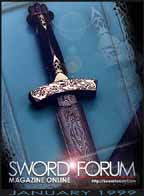 Kevin R. Cashen is certified by the American Bladesmith
Society as a Master Bladesmith. A winner of various awards including "Best
Custom Straight Knife" (for a short sword!), Kevin is well known for his
high performance art swords rarging from rapiers to Viking swords. He is also
the maker of this month's cover sword (click thumbnail to expand), which is a
Viking sword sporting pattern-welded steel and Celtic gold designs. Kevin
resides in Hubbardston, Michigan. mailto:krcashen@mvcc.com
Kevin R. Cashen is certified by the American Bladesmith
Society as a Master Bladesmith. A winner of various awards including "Best
Custom Straight Knife" (for a short sword!), Kevin is well known for his
high performance art swords rarging from rapiers to Viking swords. He is also
the maker of this month's cover sword (click thumbnail to expand), which is a
Viking sword sporting pattern-welded steel and Celtic gold designs. Kevin
resides in Hubbardston, Michigan. mailto:krcashen@mvcc.com
BACK
 [TOP] [TOP]
|